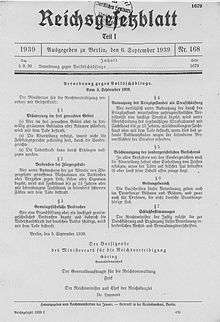Volksschädling
Volksschädling is an animal metaphor that has been mentioned in literature since 1896[1] and was first used in various contexts at the beginning of the 20th century. It gained publicity as a term for people who are characterized as "harmful organisms" because of their non-conformist behavior, usually with the intention to degrade them as vermin and to dehumanize them.
Before the Nazi takeover
In the so-called fighting time of the NSDAP this term was used to describe "traffickers and usurers" and from 1930 the term was also used for alleged traitors to the Nation.
During the war

From 1939, the designation became a legal term through its use in the Ordinance against ‘Pests harmful to the Common Good of the Country’ of 5 September 1939. According to § 4 of this ordinance, the person who "intentionally commits a criminal offence by exploiting the extraordinary circumstances caused by the state of war" was regarded as a Pest harmful to the Common Good of the Country. In this case, the offender was punished "by exceeding the regular penalty of imprisonment for up to 15 years, life imprisonment or death, if this was required by the justified popular sentiment because of the particular reprehensibility of the offence".
In the ordinance of 1939, the following type of crimes were enumerated: [2]
Roland Freisler's interpretation
Roland Freisler, Prussian State Secretary for Justice at the time, wrote about this in the legal journal Deutsche Justiz, 1939, p. 1450:
""The ordinance puts four offences at the top, they are more than offences, they are plastic images of criminals:
1. that of the looter,
2. that of the cowardly perpetrator,
3. that of the dangerous Saboteur,
4. that of the economic saboteur.""
Deserters
The content of the term Volksschädling, which was not conclusively defined in the ordinance, expanded increasingly during the course of National Socialist legal practice and, shortly before the end of the war, was used primarily to refer to deserters. In March 1945 Victor Klemperer reports of a group of field police officers wearing an armband with the inscription "Volksschädlingsbekämpfer”.[3][4]
The handling of charges relating to this Regulation was mainly assigned to the special courts. During the war, the jurisdiction of the special courts was extended to include "normal" offences. This made it possible to convict "enemies of the state" (political variant) or "Pests harmful to the Common Good of the People" (general variant), if they were also "dangerous habitual criminals", to extended terms of imprisonment.
References
- Pädagogisches Jahrbuch. Julius Klinkhardt. 1897. p. 167.
-

- Schmitz-Berning, Cornelia (2007). Vokabular des Nationalsozialismus. Berlin: de Gruyter. p. 673. ISBN 978-3-11-092864-8.
- Klemperer, Victor (1999). Ich will Zeugnis ablegen bis zum letzten. Berlin: Aufbau Verlag. p. 699. ISBN 978-3-351-03616-4.